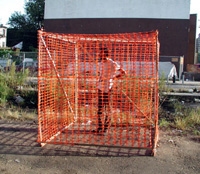public art > ORANGE WORK
ORANGE WORK
Begun in collaboration with artist Sancho Silva in 2004, Orange Work is an ongoing platform for unauthorized urban intervention projects with two primary tactics: first, the employment of orange safety material to camouflage interventions as in-process construction sites, and second, the insertion of presumably official signage into the streetscape with the intention of rewriting legal and historical frameworks.
The semiotics of florescent orange (traffic cones, tape, webbing) which orders “look here,” “stand back,” or “keep out,” is borrowed from authority actors (developers, utility companies, police), and used as a means of spatial agency. The interventions rupture prevailing spatial logics necessitating a re-negotiation public space and right of use. The general purpose here is to reveal existing spatial pressures and to temporarily reorganize public spaces for new collective possibilities.
These interventions have taken the form of observatories, bus shelters, information kiosks, rest areas, soccer fields, monuments, a solarium, and a reclining bench. The interventions have lasted periods from two days to fifteen weeks on heavily trafficked city streets, depending upon the relative friction or integration into their respective environments. The audience is manifold: from local residents of the site, who are the intended primary users, to the state with its overlapping yet self contained networks of control (sanitation, building inspectors or police), who must regard the work with paralyzing uncertainty or boredom.
Formally, the constructions must too ubiquitous in materials and facture to arouse undue attention yet too idiosyncratic to be fully submerged into the cacophonous visual noise of their urban environment—an uncanny situation of recognition/misrecognition. On closer examination, the user/observer discovers new possibilities: to sit, to stay, to gather.
The sign interventions assume the authority of the state, and what rises to the level of the historic (and therefore worthy of public notice) as well as the disciplinary priorities of parking sign or labor law notices. These works function more as long term "time release" interventions, slowly enabling a more just society to appear normative-- ongoing projects have lasted in place for more than two years.
The semiotics of florescent orange (traffic cones, tape, webbing) which orders “look here,” “stand back,” or “keep out,” is borrowed from authority actors (developers, utility companies, police), and used as a means of spatial agency. The interventions rupture prevailing spatial logics necessitating a re-negotiation public space and right of use. The general purpose here is to reveal existing spatial pressures and to temporarily reorganize public spaces for new collective possibilities.
These interventions have taken the form of observatories, bus shelters, information kiosks, rest areas, soccer fields, monuments, a solarium, and a reclining bench. The interventions have lasted periods from two days to fifteen weeks on heavily trafficked city streets, depending upon the relative friction or integration into their respective environments. The audience is manifold: from local residents of the site, who are the intended primary users, to the state with its overlapping yet self contained networks of control (sanitation, building inspectors or police), who must regard the work with paralyzing uncertainty or boredom.
Formally, the constructions must too ubiquitous in materials and facture to arouse undue attention yet too idiosyncratic to be fully submerged into the cacophonous visual noise of their urban environment—an uncanny situation of recognition/misrecognition. On closer examination, the user/observer discovers new possibilities: to sit, to stay, to gather.
The sign interventions assume the authority of the state, and what rises to the level of the historic (and therefore worthy of public notice) as well as the disciplinary priorities of parking sign or labor law notices. These works function more as long term "time release" interventions, slowly enabling a more just society to appear normative-- ongoing projects have lasted in place for more than two years.

